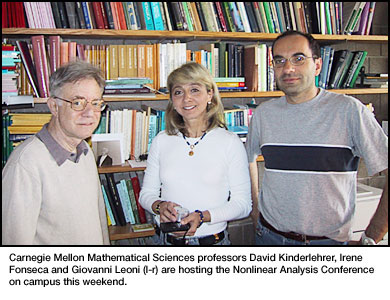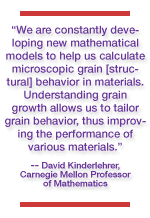|
|
||||
|
|

Carnegie Mellon Hosts Conference in Advances in Nonlinear Analysis
Some of the brightest minds in applied mathematics, from as far away as Italy and the Czech Republic, will speak about their research in applied mathematics and how it supports new developments in the related field of materials science at the Advances in Nonlinear Analysis Conference, Friday, May 30 - Sunday,
"Materials science relies on mathematical theory," said Mellon College of Science Professor Irene Fonseca, who directs Carnegie Mellon's Center for Nonlinear Analysis (CNA). "Conversely, we look at mathematical theories based on what"s up and coming in materials science research."
One of CNA's main research areas is how applied mathematics supports materials science research. The center is funded by the National Science Foundation specifically to develop and study mathematical models that, in turn, help materials science researchers study behaviors in both natural and synthetic materials. Studies of behaviors range from how these materials react under stress to how and when these stresses occur.
The practical application of mathematical models in materials science research promotes better structures in industries such as construction, medicine, electronics, and aviation.
"We are constantly developing new mathematical models to help us calculate microscopic grain [structural] behavior in materials," he said. "Understanding grain growth allows us to tailor grain behavior, thus improving the performance of various materials."
Some of these approaches incorporate nonlinear analysis, which evaluates phenomena that aren't linear — rather they are unpredictable in practice, or "bumpy." For example, Kinderlehrer employs nonlinear analysis in understanding the way materials behave at the microscopic level. This information is critical when trying to improve upon materials such as shape-memory alloys.
One of the speakers at the conference, Kaushik Battacharya, a professor from California Institute of Technology, will discuss shape-memory alloys and their practical application in small medical devices. His research seeks to understand these microstructures and how it changes as a result of forces and deformation. Battacharya has collaborated with both Fonseca and Kinderlehrer on such research.
"To make the microstructure work for us, we have to take advantage of the bumpiness in this [microstructure] energy," Kinderlehrer explained. "That requires new developments in applied math. That's our job; it's why we get out of bed in the morning."
For a complete list of conference speakers, a lecture schedule and registration information, go to the conference web site at http://www.math.cmu.edu/~ana/ or contact Giovanni Leoni, associate professor in mathematics and a conference organizer at 412-268-2557.
Susan Peich
|
||
|
Carnegie Mellon Home |
||||
 Mathematical studies are invaluable to the field of materials science, according to David Kinderlehrer, a professor of mathematics at Carnegie Mellon, who applies mathematical approaches in support of materials research. Kinderlehrer studies microstructures in relation to metallurgical grain-growth.
Mathematical studies are invaluable to the field of materials science, according to David Kinderlehrer, a professor of mathematics at Carnegie Mellon, who applies mathematical approaches in support of materials research. Kinderlehrer studies microstructures in relation to metallurgical grain-growth.